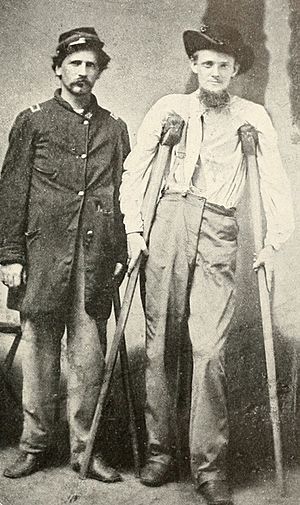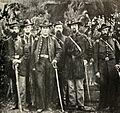Lewis R. Stegman facts for kids
Quick facts for kids
Lewis R. Stegman
|
|
|---|---|

Stegman circa 1900
|
|
| Sheriff of Kings County, New York | |
| In office 1881–1884 |
|
| Personal details | |
| Born | January 18, 1839 Brooklyn, New York City |
| Died | October 7, 1923 (aged 84) Brooklyn, New York City |
| Political party | Republican |
| Parents | Andrew Stegman Meta Margaretha Rust |
Lewis R. Stegman (born January 18, 1839 – died October 7, 1923) was an important person from Brooklyn, New York. He was a brave officer for the Union Army during the American Civil War. After the war, he worked in public service, even becoming the Sheriff of Kings County, New York.
Contents
Lewis R. Stegman's Early Life
Lewis R. Stegman was born in Brooklyn, New York City. His parents, Andrew Stegman and Meta Margaretha Rust, had moved there from Germany. He went to public schools and later studied law. He worked very hard, and sometimes spent too much time studying.
Because of this, he decided to work as a surveyor for a while. This job let him spend more time outdoors. By 1861, he was back to practicing law.
Joining the Civil War
When the Civil War began, Lewis Stegman joined the Van Buren Light Infantry. He wanted to become an officer, so he worked hard to recruit other men for his army group. He even convinced his own brother, Andrew, to join. He found soldiers from New Jersey and even Vermont.
After recruiting enough men, Stegman was chosen to be a captain. His group later became Company E of the 102nd New York Volunteer Infantry.
Battles and Challenges
In March 1862, Stegman's regiment left New York. They spent the spring near Washington, D.C., guarding supply routes for the Union Army. Stegman often went on scouting missions, likely using his surveying skills.
On August 9, 1862, Stegman was hurt in his first battle, the Battle of Cedar Mountain. A shell exploded near him, and a piece hit his head. Even with a head injury, he refused to miss the Battle of Antietam the next month. He fought with a bandage on his head.
He continued to lead Company E through 1862 and 1863. He fought in the battles of Chancellorsville and Gettysburg. At Gettysburg, he took command of the regiment when his leader, Col. James C. Lane, was wounded.
After Gettysburg, Stegman's regiment was sent west to help at Chattanooga. On November 24, 1863, he led his company in a successful attack on Lookout Mountain. A few days later, at the Battle of Ringgold Gap, he bravely led 40 men to stop the Confederates from burning a bridge as they retreated.
Promotions and Further Service
In the winter of 1863-1864, Stegman was promoted to major. This made him the second-in-command of the 102nd New York. He fought in the Atlanta Campaign, including battles at Resaca and New Hope Church in May 1864.
On June 14, 1864, Col. Lane resigned due to illness, and Stegman took command of the regiment. The next day, he led a charge against strong Confederate defenses at Pine Knob. His regiment was caught in heavy gunfire. On June 16, 1864, Stegman was shot in the leg while leading his troops.
His injury at Pine Knob meant Stegman had to leave the 102nd New York. In October 1864, he became a major in the 1st United States Veteran Volunteers. He served in Virginia but did not see major fighting. After the war ended in 1865, he received honorary promotions for his bravery. He returned home as a colonel of U.S. Volunteers.
Life After the War
After the Civil War, Stegman went back to Brooklyn, New York. He worked in several jobs, often as a journalist. In 1876, he began a career in public service. He became an under-sheriff for Kings County, New York.
He also served in the New York State Assembly in 1879. In 1881, he was elected Sheriff of Kings County. This was notable because he was a Republican elected in an area that usually voted for Democrats.
In his later years, Stegman was an important member of the New York Monuments Commission. This group worked to honor the New York soldiers who fought in the Civil War. He wrote many historical essays and spoke at events for veterans, including monument dedications at Gettysburg and Antietam. He became chairman of the commission in 1912.
Lewis R. Stegman passed away on October 7, 1923, in Brooklyn, New York. He was buried in Cedar Grove Cemetery in Flushing, New York.
Images for kids





